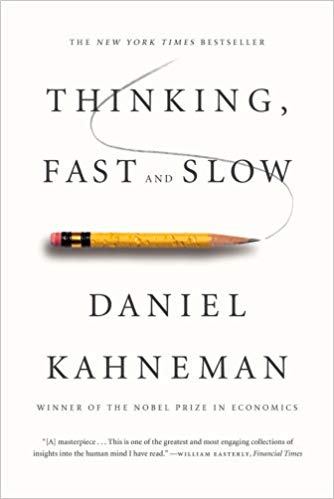Possessing strong analytical skills and solving problems is a part of everyday life– not just in entrepreneurship, but also in your personal life.
In fact, we would go as far as to say that if you aren’t encountering problems every once in a while, and subsequently conquering them, are you even a real entrepreneur?
However, being an entrepreneur, and by extension, an excellent problem solver, you’re going to need a few tricks up your sleeve. You’re in luck today.

Thinking Fast and Slow
by Daniel Kahneman
⏱ 14 minutes reading time
🎧 Audio version available
Trick #1: Be Impatient
The first trick we’ve got to share is to jump into action. Take immediate steps to tackle this problem. As you know by now, entrepreneurship isn’t a wise career path for people who tend to put things off or procrastinate.
The next time a problem rears its ugly head, tackle it immediately. By “tackling it,” we mean executing our next piece of advice. This is not the same as hurrying into a decision, which could possibly make things worse. Being impatient about solving problems means you’re eager to solve them instead of letting things run their own disastrous course.
Trick #2: Digest
When they find themselves in a bind, a lot of people go with the first decision or plan of action that comes to mind. While you need to get a jumpstart on solving the problem, you should never make a business decision in a hurry. In order to be a successful entrepreneur, coming up with a system that helps you think critically is a must.
The next step is to digest, which in this case means thinking critically about the problem. Digesting means not immediately going with the first idea. Take the time to digest the problem before you even think about offering a solution.
Critical thinking, the ability to logically digest problems, is vital for your business. It’s going to help you grow your brand. And it works for every aspect of the job, including finances, marketing, and when dealing with employees and investors.
And most importantly, it’s going to ensure that your solution is effective and long lasting– as in, it’s not going to circle back with an additional problem.
Analyze every factor on hand. To avoid procrastination, set a strict deadline for when you need to find a solution.
Trick #3: The Five Whys
You know those little kids who constantly bombard people with ‘why’ questions? They may be on to something. Because answering all those ‘why’ questions will help you come up with new and innovative solutions.
Today, we want to be that annoying kid. Ask many ‘whys’ as you want. Be as unsatisfied as that kid is. This is how you’re going to get to the bottom of the problem. With every “why,” you’re digging deeper.
Most notably, you’re gaining insight. This is also related to not going with the first decision you come up with. Never be satisfied with the first solution you find to your first “why.”
After solving the first question, continue asking why. Not sure how many “whys” you need? Here’s an extra trick.
The Five “Whys.”
The technique was created by none other than Toyota– aka, one of the oldest and most reliable car producing companies of all time. The Five Whys were proposed by Japanese inventor and industrialist, Sakichi Toyoda; who was known as the “King of Japanese Inventors”. He’s the one who started the Toyoda family companies. Later on, his son would establish Toyota, the largest automaker in Japan.
So that king of industry made the 5 Whys part of the Toyota Production System. It goes like this: whenever they encounter a problem, Toyota’s scientific approach is to ask “why” a total of five times. Then, not only the solution becomes clear, but also the very nature of the problem.
We’re looking to be problem-solving, analytical business people, and a major part of that is knowing how to make informed decisions. The 5 Whys are magic when it comes to clearing that fog.
The first ‘why’ will reveal a superficial analysis. Being persistent will find the real cause of the problem so that you can find lasting solutions.
Like Toyota, you want to understand what’s happening on the work floor, so you prod and inspect it until a clear reason for that problem is revealed.
The Toyota website states that “whenever a problem cropped up, Taiichi Ohno encouraged his staff to explore problems first-hand until the root causes were found.” “Observe the production floor without preconceptions,” he would advise. “Ask ‘why’ five times about every matter.”
There are a lot of ways you can approach this technique. Some people like to hold meetings to brainstorm. Others work alone. Some move past the five question mark and ask as many ‘whys’ as they want– as many as it takes to get to the root of the problem and clarify the necessary action.
The method depends on following step after step. And we cannot emphasize this enough: don’t hurry. And don’t jump to conclusions.
Your answers to the ‘whys’ should be based on facts and concrete knowledge. Look at the process and assess it before you get started on assessing the people involved.
Since we’re talking about Toyota, let’s use them for an example. Our scenario is a conveyor belt has stopped.
First Why: Why did the conveyor belt stop?
The pulley that rotates the belt isn’t working.
Second Why: Why is the pulley not rotating the belt?
There is not enough power.
Third Why: Why isn’t there enough power?
The motor has stopped working.
Fourth Why: Why isn’t it working?
It burnt out.
Fifth Why: Why is it burnt out?
The motor was overloaded past its power capacity.
Sometimes, it may take more than five whys, but you can usually trace the problem back to its origins and figure out where to go from there.
Where do you go from there? Here is the next trick!
Trick #4: Failure Mode and Effects Analysis
The Failure Mode and Effects Analysis, also shortened to FMEA, is a step by step technique for solving problems that the U.S. military started in the 1940s to identify possible failures in a design, product, service, or manufacturing process.
The gist of it is that FMEA is basically reviewing all that you can– the components, the subsystems, et cetera. This is how you can identify any potential failures, their causes, and effects. There is actually a FMEA worksheet you can use.
While this technique originally began as a military thing, who’s to say it can’t be applied to entrepreneurship? You can use it anytime– when you’re designing a product or a service, when you’re testing quality, when you’re developing control plans, when you’re trying to improve an existing process, or generally throughout the life of your business.
Go Crazy With Generating Ideas
It’s only logical that you’re going to have an abundance of ideas to address to your problem by now. You have all the relevant information on hand, the causes are clear, and you need to get a move on.
Each idea you come up with should be evaluated for practicality and feasibility. Weigh the cost of each solution. With every solution, there is bound to be a trade-off. The advantages and disadvantages of that should be analytically considered as well. Sometimes, while the cost is tempting, it may not be practical. Bounce around ideas and assess each one to find the one that’s most efficient, cost-friendly, and is feasible for all sides involved.
Related: How to Approach Solving Most Common Startup Problems
Walk Through the Execution
It’s show time! This is the moment you implement your solution, but first, the trick to nailing it is to walk through how the execution should go. Test every factor of the solution, each part, and if it wors, you’re good to go.
However, you won’t make it long as an entrepreneur if your implementing skills– and by extension, your problem solving skills– aren’t up to code. The final step in analytical thinking is assessing the final solution. Believe it or not, but this is something that’s often overlooked.
Just because you have a solution doesn’t mean it’s the final solution. Remember that thing about lasting solutions? The final part, the show time, is continually testing whether or not this is the final solution. You never know, knowing all these nifty tricks may be what propels you ahead of the competition!
What Is Snapreads?

With the Snapreads app, you get the key insights from the best nonfiction books in minutes, not hours or days. Our experts transform these books into quick, memorable, easy-to-understand insights you can read when you have the time or listen to them on the go.


